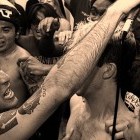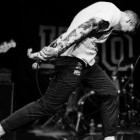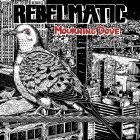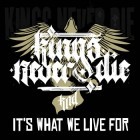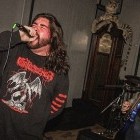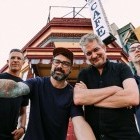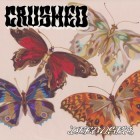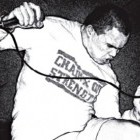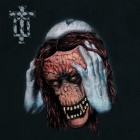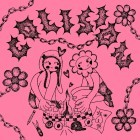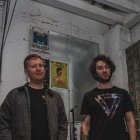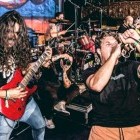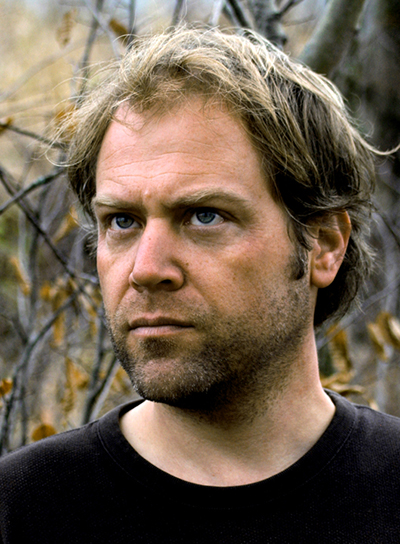
If you've been a devout fan of extreme heavy metal for the last couple of decades, then you certainly own albums with Dan Seagrave's signature artwork adorning their covers.
Altars of Madness, Left Hand Path, Like an Ever Flowing Stream, and Effigy of the Forgotten are just a few of the seminal death metal album covers that the British artist has painted throughout his career.
Just as influential as he's been prolific, he's spawned many imitators, but no one can come close to creating the kinds of netherworlds and phantasmagoric scenes that Seagrave dreams up.
Aside from his busy work in the music world, Seagrave works on personal projects that have been known to take up to a year for just one painting. He's recently also delved into filmmaking and visual effects. A medium he'll surely leave his stamp on.
Growing up collecting many of the albums Seagrave has worked on since the late '80s, I was excited to chat with the Canada-based artist.
Let's go back to your childhood. When did you first realize you had this gift for art?
It was probably at the age of 4 or 5. I was making drawings with perspective. That's probably something that is common when a person has a technical eye. For me, it was always about an internal visual side. Using imagination, so all the things I drew were ideas I had. I was just into that. And you start noticing that it's not something everyone else is doing.
Did you have artistic influences from the get-go or did you just gravitate towards a certain type of style, and not necessarily a specific artist?
I liked films, and that would have been my earliest connection with imaginative images, I think; old science fiction, fantasy films or horror TV shows that happened to be on television. We had a few books around the house. The horror book covers of Justin Todd was a great influence. So was M.C. Escher. My dad was more into artists like Renoir and Titian. I wasn't so into that at an early age, so I didn't appreciate that 'til later. At that early age, I was certainly more fascinated by pictures that displayed unreal ideas, and things of the imagination. Even then I knew it was more appealing than some degree of everyday life; an escape of sorts.
According to the bio on your website, you're schooling experience wasn't a positive one. Did they not support your artistic interests?
Not really. Though, I suppose, that was not the school's priority. It was just a plain village school and not the best place for being a dreamer or a creative type. I don't hold any grudges particularly about that. It's just a fact that it was disappointing, and I was not the personality type for regular school.
You landed your first album cover job at the age of 17 for a label called R.K.T. Records.
It was for Lawnmower Deth, a local band from the same village I'm orginally from: Ravenshead, near Nottingham.
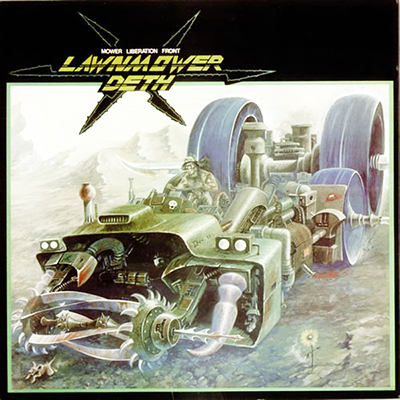
I landed it because I knew them, and they made the mistake of mentioning they had a record deal. So I insisted that I paint a cover for their record, which I did, and subsequently made a second cover for the B-side, which was another band called Metal Duck, from Manchester. It became a sort of well-known underground/indie joke metal thrash hit.
The work you did for the R.K.T. Records eventually got in the hands of someone influential labels.
I did work for R.K.T., but then that was seen by Earache Records, so I worked for them second. Earache had more of an international effect even though they were just starting out. It was the Morbid Angel cover [Altars of Madness, 1989] that caught the attention of other labels. So, in 1990, I did my first piece for Roadrunner, which was At Death's Door: A Collection of Brutal Death Metal [1990]. They named the album after my painting title. The art was pretty bad, if I'm being honest. It was done really quickly, as I had to fly away for two months immediately after.
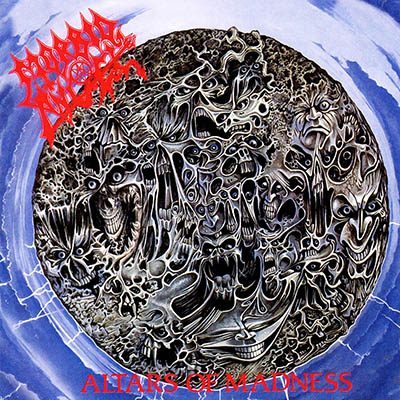
Once you started working with Roadrunner Records, it seemed like you had a new cover popping up every few months. Tell me about that period in the early '90s.
I did that At Death's Door piece in early summer 1990, and when I returned from my journey. It was probably October when I heard from them again. I then did The Ten Commandments piece for Malevolent Creation in 1991. After that, I think they were keener on what I had to offer. So I was doing pieces for them somewhat frequently after that. Between Roadrunner and the other labels I was working with, I guess I had created a job for myself for a while. I started to feel good in the sense that it was independent, and something unique. That was my own creation, and also a part of something bigger.
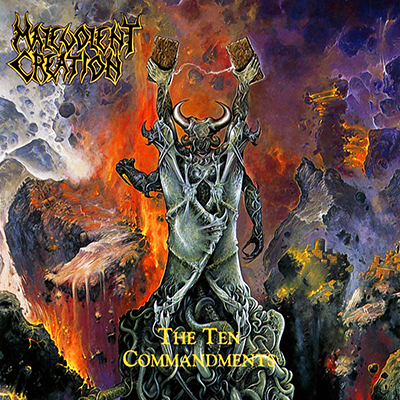
I really liked the fact that this particular metal genre [death metal] was advanced and different from earlier metal. That it was defined on its own terms, a new scene. To me, that was a really important factor, because it meant that I had a chance to define my work within that, which I knew would, in the long run, be something worth reflecting on. So I did try extra hard to make the artwork almost classical in a visual sense, and not just doing it as quickly as I could and not caring. I spent as much time as I could to get the result I wanted.
Can you walk me through the process you go through before you start a new cover? Do you ever get to hear the album before you start?
Sometimes I get to hear the album, often not. In a way, so long as the music and production are good, that's fine. To generate visual ideas, I like to know the album title, and the general theme of the album. I prefer limited, but good and concise information, which then allows images to appear in the mind. Sometimes a client has a definitive visual concept, and they just want me to render it. That can work, but, sometimes, if I don't like the idea, I can't do it. For me, I feel that a client should approach me to get my ideas, not just me rendering their idea. And perhaps, I'm less of an illustrator as a result.
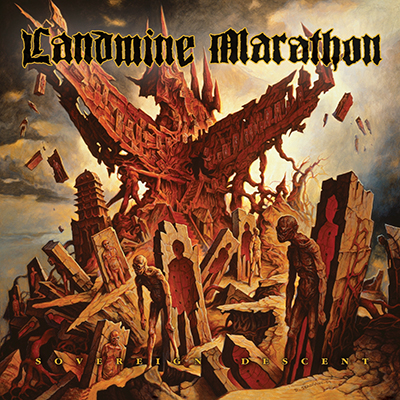
Were there any bands/labels that didn't end up using your artwork?
It's happened a few times, but they still have to pay.
What are your personal listening habits like? Do you still listen to a lot of extreme metal?
I like all kinds of sounds. I've never been aligned to any genre in terms of what I like musically. I like metal, yes, but, I also listen to some pop, alternative sounds, dark electronic, experimental, and atmospheric types of music. For metal, I prefer to go to the shows or festivals. For me, this is way more fun as a complete experience, with other people. And you can also have a drink then, and meet some folks
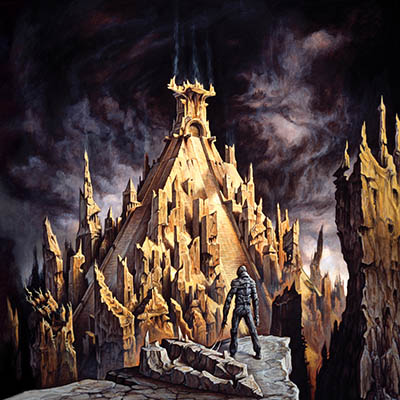
You've worked with the biggest indie heavy metal labels of all time. You've been behind some of the most iconic album covers in extreme metal history. Of all your accomplishments in the metal arena, what are you most proud of?
I like the term "biggest indie labels." I've been surprised in the last year at some of the events I've attended such as Comicon, Fan Expo and various metal fests, because people seem to know who I am, and have been pleased to meet me, which is a new thing for me. I think then, that I'm only getting to feel that accomplishment just recently, as before I was always in the background working remotely and not connected. I'm pleased that I've made 100 plus covers now, and there is some considerable work there as a collection, as a whole body to reflect upon. I think that is the important thing. If I'd only made 10 covers no one would care. But they all feed back into one another to contribute to the whole. I guess I am also saying there is not [just] one thing.
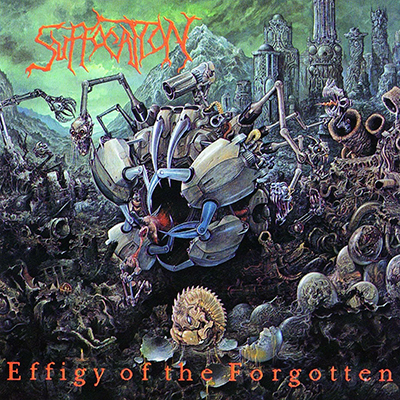
Your covers always feel otherworldly. I would love to see someone make a big budget movie inspired by one of the landscapes you've created. Have you ever been approached by a movie studio?
There are too many artists doing great concept work in film. Artists don't often get approached, I don't think. I've tried to get involved myself by being proactive, and not waiting for a call that will never happen. I approached Weta Workshop for Lord of the Rings way back in 1997, and had a back and forth with Richard Taylor for a few years via mail. But no work came out of it. I approached and met with Les Tomkins [Stanley Kubrick's production designer], and also Steven Scott [Hellboy], and the Harry Potter art department back in 2005. The latter of which were going to hire me, but in the end didn't. It's a tough nut to crack. But I'm into writing my own film ideas in recent years, and I've made a few shorts. I just like the whole moving image world, really. So, creatively, I feel keen to make more artistic short films of my own. But I also enjoy trying out a few scripts. Writing is also interesting to me, when I can get down to it.
Who are some contemporary artists that you can recommend to our readers?
I go to the odd opening here in Toronto. I like the work of Kris Kuksi, and the Chapman Brothers. I need to get back to New York, though, and be back in the loop a bit.
What are your latest projects and can we expect any new album covers in the near future?
I'm doing some art for the bands Incite, Kaotic and Decimation. I'm still working on my series called Migrators. I have another series, an offshoot from the Temple series, which I'm also trying to make into a short, partly animated film. And I am writing a few bits. Some script ideas. There isn't enough time to do all of the things I'd like to do.
Head to www.DanSeagrave.com to buy prints and see more of his original artwork.
